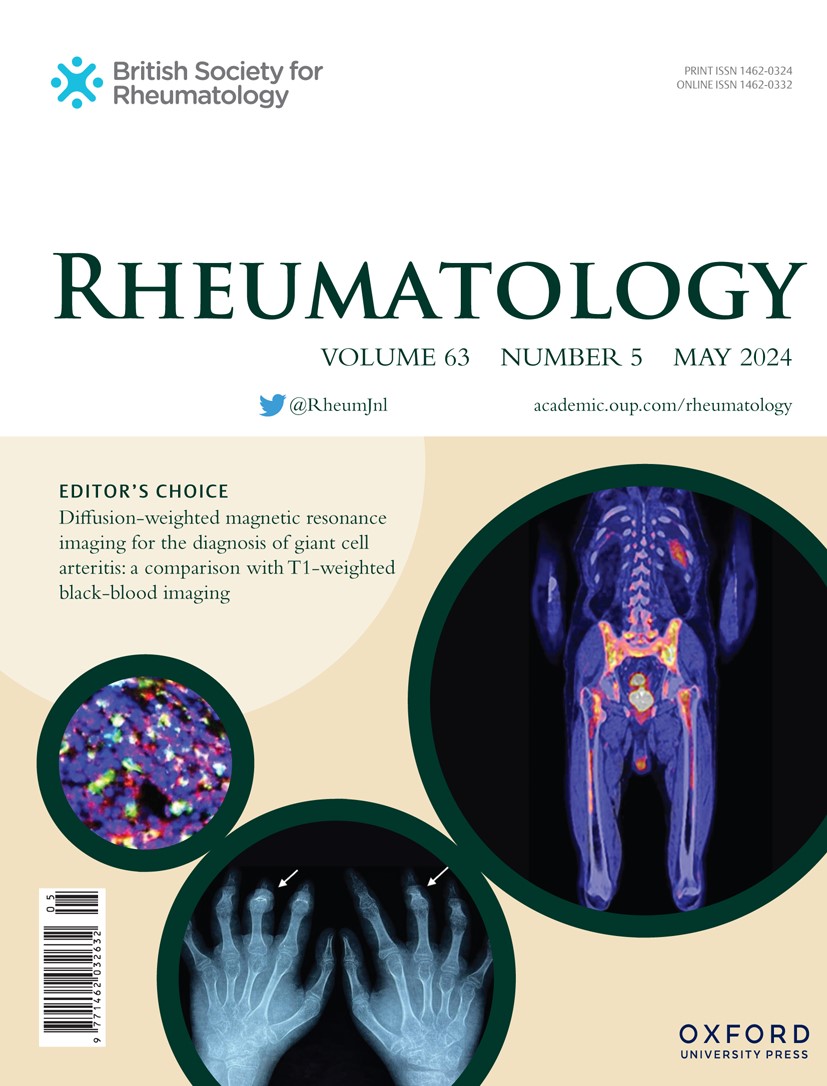OA42 Impact of immunosuppression on development and outcome of systemic sclerosis-associated pulmonary arterial hypertension
IF 4.7
2区 医学
Q1 RHEUMATOLOGY
引用次数: 0
Abstract
Background/Aims Pulmonary arterial hypertension (PAH) is a severe complication of systemic sclerosis (SSc). Treatment of SSc-PAH follows the same approach of idiopathic PAH and mainly relies on the combined action of vasodilators. Although immunosuppression might be expected to have a role considering the evidence of autoimmunity and immune dysfunction in the pathogenesis of SSc-PAH, evidence for benefit in prevention or treatment is lacking. The aim of this study was to retrospectively assess whether early immunosuppression impacts development of SSc-PAH or alters survival in patients with an established diagnosis. Methods We included 629 patients meeting the 2013 ACR/EULAR classification criteria for SSc. Early immunosuppression was defined as treatment in the first 5 years since SSc onset with either prednisolone equivalent at a dose ≥10mg daily, conventional synthetic or biologic DMARDs. Pre-capillary pulmonary hypertension (PH) was defined as mean pulmonary artery pressure ≥ 25mmHg, pulmonary vascular resistance >3 WU, pulmonary wedge pressure ≤15mmHg at right-heart catheterization. In case of precapillary-PH and concomitant ILD, we considered it PAH in case of forced vital capacity >70% (i.e. INCREASE trial exclusion criteria for group 3 PH). Outcomes of interest were development of PAH, time from SSc diagnosis to PAH, and survival in patients with PAH. Descriptive statistics, logistic and linear regression, Kaplan-Meier and Cox regression analysis were performed with STATA-18®. 31st December 2023 was chosen as the censorship date for survival analysis. Variables with p value <0.05 in univariate analysis were included in multivariate analysis. P value <0.05 was defined as statistically significant. Results Complete clinical and therapy data were available for analysis in 607 patients, of whom 206 received early immunosuppression. A total of 77 patients received a diagnosis of PAH, among which 11 were in the early immunosuppression group. After adjusting for potentially significant confounding variables, early immunosuppression was not associated to reduced odds of developing PAH (OR 0.74, 95% CI 0.31-1-76; p = 0.495), and time from SSc onset to PAH diagnosis was superimposable between the three treatment groups (i.e. 10.5 years for ‘early immunosuppression’, 11 years for ‘late immunosuppression’, and 11 years for ‘never immunosuppression’; p = 0.581). Survival analysis in patients with PAH included 70 patients. Immunosuppression was associated with a reduced risk of mortality, however, this did not reach statistical significance (HR 0.41, CI 0.16 - 1.04; p = 0.60). When analysing single agents, hydroxychloroquine was associated with reduced mortality risk (HR 0.06, CI 0.01 - 0.52; p = 0.011), while all the other agents did not significantly affect mortality. Conclusion Early immunosuppression does not seem to impact development of PAH or survival in SSc-PAH, however treatment with hydroxychloroquine is associated with reduced mortality in SSc-PAH. Considering the limitations of a retrospective approach, further prospective evidence is warranted. Disclosure S. Rodolfi: None. V.H. Ong: None. C.P. Denton: None.免疫抑制对系统性硬化症相关性肺动脉高压的发展和预后的影响
背景/目的肺动脉高压(PAH)是系统性硬化症(SSc)的严重并发症。SSc-PAH的治疗方法与特发性PAH相同,主要依靠血管扩张剂的联合作用。考虑到自身免疫和免疫功能障碍在SSc-PAH发病机制中的证据,尽管免疫抑制可能发挥作用,但缺乏预防或治疗益处的证据。本研究的目的是回顾性评估早期免疫抑制是否会影响SSc-PAH的发展或改变确诊患者的生存。方法纳入629例符合2013年ACR/EULAR分级标准的SSc患者。早期免疫抑制被定义为在SSc发病后的前5年内使用泼尼松龙当量,每日剂量≥10mg,常规合成或生物dmard。毛细血管前肺动脉高压(PH)定义为右心导管置管时平均肺动脉压≥25mmHg,肺血管阻力≥3wu,肺楔压≤15mmHg。对于毛细血管前PH和伴随的ILD,我们认为在强制肺活量达到70%的情况下为PAH(即增加3组PH的试验排除标准)。关注的结果是PAH的发展,从SSc诊断到PAH的时间,以及PAH患者的生存。采用STATA-18®进行描述性统计、logistic和线性回归、Kaplan-Meier和Cox回归分析。2023年12月31日被选为生存分析的审查日期。单因素分析中p值为&;lt;0.05的变量纳入多因素分析。P值&;lt;0.05被定义为具有统计学意义。结果607例患者有完整的临床和治疗资料可供分析,其中206例接受了早期免疫抑制。共有77例患者被诊断为PAH,其中11例为早期免疫抑制组。在调整了潜在的重要混杂变量后,早期免疫抑制与PAH发生几率的降低无关(OR 0.74, 95% CI 0.31-1-76;p = 0.495),从SSc发病到PAH诊断的时间在三个治疗组之间是重叠的(即“早期免疫抑制”10.5年,“晚期免疫抑制”11年,“从未免疫抑制”11年;P = 0.581)。70例PAH患者的生存分析。免疫抑制与死亡风险降低相关,然而,这没有达到统计学意义(HR 0.41, CI 0.16 - 1.04;P = 0.60)。当分析单一药物时,羟氯喹与降低死亡风险相关(HR 0.06, CI 0.01 - 0.52;P = 0.011),而其他药物对死亡率无显著影响。结论早期免疫抑制似乎不影响SSc-PAH的发展或生存,但羟氯喹治疗与SSc-PAH死亡率降低相关。考虑到回顾性方法的局限性,进一步的前瞻性证据是必要的。S.鲁道夫:没有。h . h . Ong:没有。C.P.丹顿:没有。
本文章由计算机程序翻译,如有差异,请以英文原文为准。
求助全文
约1分钟内获得全文
求助全文
来源期刊

Rheumatology
医学-风湿病学
CiteScore
9.40
自引率
7.30%
发文量
1091
审稿时长
2 months
期刊介绍:
Rheumatology strives to support research and discovery by publishing the highest quality original scientific papers with a focus on basic, clinical and translational research. The journal’s subject areas cover a wide range of paediatric and adult rheumatological conditions from an international perspective. It is an official journal of the British Society for Rheumatology, published by Oxford University Press.
Rheumatology publishes original articles, reviews, editorials, guidelines, concise reports, meta-analyses, original case reports, clinical vignettes, letters and matters arising from published material. The journal takes pride in serving the global rheumatology community, with a focus on high societal impact in the form of podcasts, videos and extended social media presence, and utilizing metrics such as Altmetric. Keep up to date by following the journal on Twitter @RheumJnl.
 求助内容:
求助内容: 应助结果提醒方式:
应助结果提醒方式:


